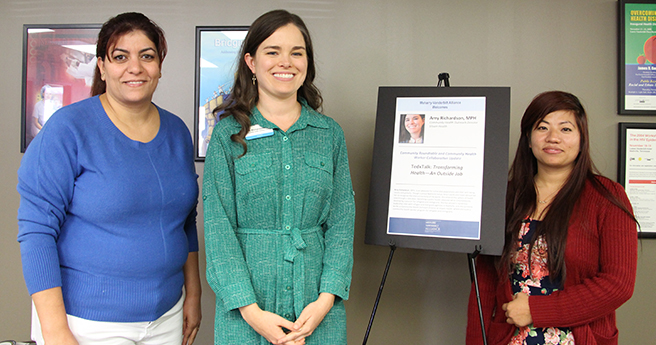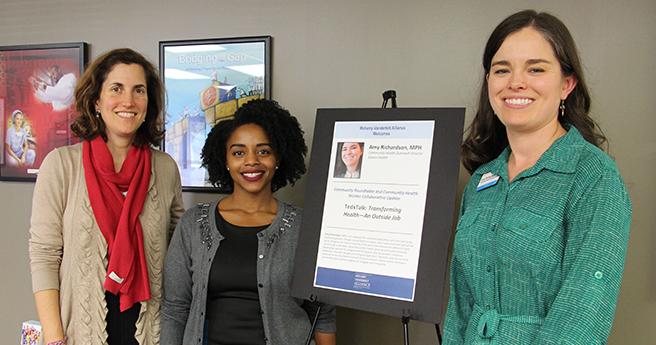
Photo by Matt Schorr
Pictured from left to right are Community Health Worker Evon Ishak, Siloam Health Community Outreach Director Amy Richardson, MPH and Community Health Worker Hannah Rai.
NASHVILLE, Tenn. Siloam Health Community Outreach Director Amy Richardson, MPH presented a TedxTalk to researchers and community stakeholders October 26, 2017, during a Community Roundtable and Community Health Worker Collaborative Update at the Meharry-Vanderbilt Alliance (MVA).
During her talk, Richardson highlighted the importance and potential of utilizing Community Health Workers (CHWs) in modern healthcare, a model Siloam Health has recently championed. “Community Health Workers have been used in global health for centuries with positive results,” she said.
Community Health Workers
CHWs are lay community members who support health education and positive health behaviors, bridge cultural and linguistic barriers to good health and help expand access to care, among other duties and roles. Responsibilities of CHWs may include home visits, group support, helping clients with medical encounters, advocacy and linking community members to resources.
Studies have shown positive impacts of CHWs in a number of areas including diabetes, cardiovascular disease and asthma.
Hannah Rai
During her talk, Richardson recounted the story of Hannah Rai, a refugee from Bhutan who is now a CHW at Siloam Health. “Hannah and her family were forced to flee their home country when its government began carrying out a brutal ethnic cleansing,” Richardson said.
Hannah ultimately moved to Nashville, where she became a CHW serving other refugees.
A tool for healthcare reform
Richardson argued that CHWs can be a vital tool in healthcare reform. According to recent studies, social determinants account for roughly 80 percent of a person’s health. Unfortunately, America invests the majority of its funding in the remaining 20 percent – healthcare services.
“We’re not as individualized as we’d like to think,” Richardson said.
However, the CHW model, she said, is an approach that maximizes connectivity.
“CHWs can help with health literacy,” Richardson explained. “They can break down barriers and capitalize on cultural strengths.”
Today, there are over 48,000 CHWs in the United States.
“Let’s resolve for dignity in the digital age, and keep humanity at the heart of health,” Richardson said.

Photo by Matt Schorr
Pictured from left to right are MVA Director of Planning and Community Engagement Elisa Friedman, MS, MVA Program Coordinator II Jacquelyn Favours, MPH, CHES and Siloam Health Community Outreach Director Amy Richardson, MPH.
The Community Health Worker Collaborative
The Community Health Worker Collaborative, an emerging group of CHW advocates being convened by the MVA, followed the TedxTalk and discussion. The update detailed the Collaborative’s plans to engage CHWs and organizations that work with them statewide. In addition, the Collaborative plans to launch a statewide CHW survey in late November. To get involved in the Collaborative or for additional information, please contact Jacquelyn Favours at jacquelyn.s.favours@meharry-vanderbilt. org.
About the Meharry-Vanderbilt Alliance
Founded in 1999, the Alliance bridges the institutions of Meharry Medical College and Vanderbilt University Medical Center. Its mission is to enrich learning and advance clinical research in three primary areas -- community engagement, interprofessional education and research -- by developing and supporting mutually beneficial partnerships between Meharry Medical College, Vanderbilt University Medical Center and the communities they serve. Through community engagement, the Alliance serves a large community of stakeholders including surrounding universities and colleges, community organizations, faith-based outlets and community health centers. Its interprofessional education enhances students' interdisciplinary understanding and improves patient outcomes through integrated care. The research conducted provides access to experienced grant writers and materials supporting the grant application process and facilitates grant-writing workshops.




